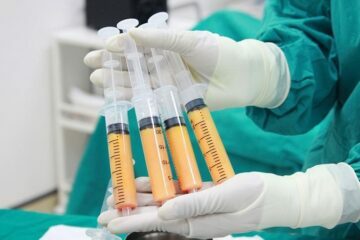Unlocking the Power of Otay Mesa: The Plasma Donation Guide

Table of Contents
Key Takeaways:
- Plasma donation can save lives by providing essential proteins and antibodies for medical treatments.
- Plasma has medical applications beyond transfusions, such as treating severe burns and autoimmune diseases.
- Regular plasma donation can help with weight management and promote improved blood circulation.
- Plasma donation involves a screening process and a donation procedure using a plasmapheresis machine.
- Tips for successful plasma donation include staying hydrated, eating a balanced diet, getting enough rest, and following instructions.
- To start plasma donation, find a reputable donation center, prepare mentally and physically, and be aware of post-donation effects.
- Maintaining a healthy lifestyle and disclosing medications and medical conditions are important considerations for plasma donors.
- Donation centers prioritize safety and adherence to infection control protocols during the donation process.
The Benefits of Plasma Donation
Plasma donation is a powerful and potentially life-saving act that can have numerous benefits for both donors and recipients. By donating plasma, individuals have the opportunity to directly contribute to the well-being and health of others. Let’s explore the various benefits of plasma donation in more detail:
1. How Plasma Donation Can Save Lives
One of the most significant benefits of plasma donation is its potential to save lives. Plasma, the liquid portion of blood, contains essential proteins and antibodies that are used in various medical treatments. Donated plasma is processed into different therapeutic products, such as immunoglobulins, clotting factors, and albumin, which are vital for patients with immune deficiencies, bleeding disorders, and burns.
Patients with conditions like primary immunodeficiency disorders, liver diseases, and hemophilia rely on regular access to plasma-based therapies. By donating plasma, individuals can help ensure that these life-saving treatments are available to those in need.
2. The Medical Applications of Plasma
Plasma has numerous medical applications beyond transfusions. For example, the plasma-derived protein albumin is used to treat patients with severe burns, as it helps maintain blood volume and prevent infection. Additionally, plasma is also used in the production of therapies for autoimmune diseases, neurological disorders, and certain types of cancers.
By donating plasma, individuals can help support ongoing research and development of new plasma-derived therapies. These advancements can lead to improved treatment options for a wide range of medical conditions, benefiting patients worldwide.
3. The Health Benefits of Regular Plasma Donation
Not only does plasma donation have the potential to save lives and contribute to medical advancements, but it also offers health benefits for donors themselves. Regular plasma donation can help individuals maintain a healthy weight by burning excess calories. The process of replenishing plasma also stimulates the production of new blood cells, leading to improved overall blood circulation.
Furthermore, when donating plasma, donors undergo a thorough screening process, including testing for infectious diseases. This screening can help identify any underlying health conditions that donors may not have been aware of, allowing them to seek appropriate medical care and treatment.
The Process of Plasma Donation
Before embarking on the journey of plasma donation, it is essential to understand the entire process. From screening to the donation procedure itself, being well-informed can help make the experience more comfortable and rewarding. Let’s take a closer look at the process of plasma donation:
1. The Screening Process: What to Expect
Prior to each plasma donation, donors undergo a screening process to ensure the safety of both the donor and the recipient. This process typically involves a detailed medical questionnaire to assess the donor’s health history, lifestyle factors, and potential risk factors for infectious diseases. Donors may also have their vital signs, such as blood pressure and pulse, measured during this stage.
Additionally, blood samples are taken to conduct laboratory tests, including screening for infectious diseases such as hepatitis, HIV, and syphilis. Donors will also be asked about any recent travel or exposure to certain medical conditions. This comprehensive screening process helps ensure the quality and safety of donated plasma.
2. Understanding the Donation Procedure
Once the screening process is complete, donors are prepared for the plasma donation procedure. The actual donation typically takes around 45 minutes to an hour. During the procedure, a trained healthcare professional uses a sterile needle to draw blood from the donor’s arm. The blood is then passed through a machine called a plasmapheresis machine, which separates the plasma from the other components of the blood.
The plasma is collected, while the remaining components, such as red blood cells and platelets, are returned to the donor’s body. This process allows for repeated plasma donations without depleting the donor’s overall blood volume. Most individuals tolerate the procedure well, experiencing minimal discomfort.
It is important to note that plasma donation should always be performed at licensed and reputable plasma donation centers that follow strict safety and quality standards.
3. Tips for a Successful Plasma Donation
To ensure a successful plasma donation, there are a few important factors to consider:
- Hydration: It is crucial to drink plenty of fluids, preferably water, in the days leading up to the donation. Staying well-hydrated helps ensure a smoother donation process.
- Nutrition: A balanced diet rich in iron and protein can help maintain optimal blood production and overall health. Eating a nutritious meal before donation can help prevent lightheadedness or dizziness.
- Rest: Prioritize getting a good night’s sleep before donating plasma. While the donation process itself is relatively stress-free, being well-rested can make the experience more comfortable.
- Follow Instructions: Listen carefully to the instructions provided by the healthcare professionals at the donation center. They will guide you through each step of the process and answer any questions or concerns you may have.
Getting Started with Plasma Donation
If you are considering donating plasma for the first time, it is important to know how to get started and what to expect throughout the process. Let’s explore the necessary steps:
1. Finding a Reputable Plasma Donation Center
The first step in getting started with plasma donation is finding a reputable donation center. Look for centers that are licensed and regulated by relevant authorities, ensuring compliance with safety and quality standards. Research online reviews and ask for recommendations from friends or healthcare professionals to find a center that meets your needs and preferences.
Once you have identified a center, reach out to them for more information about their donation process, eligibility requirements, and any compensation provided for donors. It is essential to choose a center where you feel comfortable and supported throughout the donation journey.
2. Preparing for Your First Donation
Prior to your first plasma donation, it is important to prepare both mentally and physically. Make sure to eat a healthy meal, hydrate well, and get plenty of rest. Wear comfortable clothing with sleeves that can be rolled up easily to facilitate the donation process.
Bring any necessary identification documents and complete any required paperwork or online registration processes before arriving at the donation center. It is also advisable to bring a form of entertainment, such as a book or music, to occupy your time during the donation process.
3. What to Expect After Donating Plasma
After donating plasma, it is normal to experience some mild side effects, such as temporary fatigue, dizziness, or lightheadedness. These symptoms usually resolve within a short period. It is important to rest and hydrate adequately after donation to help your body recover.
Donation centers often provide post-donation snacks or beverages to replenish your energy levels. Follow any specific post-donation instructions provided by the center, and reach out to them if you have any concerns or persistent side effects.
Important Considerations for Plasma Donors
While plasma donation is a rewarding and beneficial process, there are a few important considerations for donors to keep in mind. These considerations ensure both the safety and comfort of the donors, as well as the quality of the donated plasma:
1. Maintaining a Healthy Lifestyle for Optimal Donation Results
Leading a healthy lifestyle can contribute to optimal plasma donation results. Regular exercise, a balanced diet, and adequate sleep can help maintain overall health and ensure a successful donation experience. Avoiding excessive alcohol consumption and refraining from smoking before donation is also advisable.
Additionally, maintaining proper hydration by drinking plenty of water not only enhances the donation process but also supports overall well-being. Following these lifestyle practices can help donors feel their best before, during, and after plasma donation.
2. The Impact of Medications and Medical Conditions on Plasma Donation
Prior to plasma donation, it is important to disclose any medications or medical conditions to the healthcare professionals at the donation center. Certain medications, such as blood thinners, may affect the suitability of plasma donation. Medical conditions such as pregnancy, recent surgeries, or chronic illnesses may also impact the eligibility for donation.
Honesty and transparency are key in ensuring the safety of both donors and recipients. The healthcare professionals at the donation center can guide you on any specific restrictions or requirements based on your medical history.
3. Ensuring Safety and Comfort During the Donation Process
The safety and comfort of donors during plasma donation are of paramount importance. Donation centers adhere to strict infection control protocols to minimize any risks to donors. The equipment used for donation is sterile, and all healthcare professionals follow proper hand hygiene and personal protective measures.
If you have any concerns or questions about the donation process, do not hesitate to communicate with the healthcare professionals at the center. They are experienced in guiding donors through the process and ensuring a safe and comfortable experience for all.
By unlocking the power of Otay Mesa plasma donation, individuals have the opportunity to make a significant impact on the lives of those in need. Whether it be saving lives, supporting medical advancements, or reaping personal health benefits, plasma donation is an act of compassion and generosity. Take the first step and explore plasma donation centers in your area to unlock the potential within you.
FAQ
Question: What are the benefits of plasma donation? Answer: Plasma donation can save lives by providing essential proteins and antibodies for medical treatments. Plasma also has medical applications beyond transfusions, such as treating severe burns and autoimmune diseases. Additionally, regular plasma donation can help with weight management and promote improved blood circulation.
Question: How does plasma donation save lives? Answer: Plasma, the liquid portion of blood, contains essential proteins and antibodies that are used in various medical treatments. Donated plasma is processed into different therapeutic products, such as immunoglobulins, clotting factors, and albumin, which are vital for patients with immune deficiencies, bleeding disorders, and burns. By donating plasma, individuals can help ensure these life-saving treatments are available to those in need.
Question: What are the medical applications of plasma? Answer: Plasma has numerous medical applications beyond transfusions. For example, the plasma-derived protein albumin is used to treat patients with severe burns, as it helps maintain blood volume and prevent infection. Plasma is also used in the production of therapies for autoimmune diseases, neurological disorders, and certain types of cancers.
Question: What are the health benefits of regular plasma donation? Answer: Regular plasma donation can help individuals maintain a healthy weight by burning excess calories. The process of replenishing plasma also stimulates the production of new blood cells, leading to improved overall blood circulation. Additionally, the screening process involved in plasma donation can help identify any underlying health conditions that donors may not have been aware of, allowing them to seek appropriate medical care and treatment.
Question: What should I expect during the screening process? Answer: Prior to each plasma donation, donors undergo a screening process to ensure the safety of both the donor and the recipient. This involves a detailed medical questionnaire to assess the donor’s health history, lifestyle factors, and potential risk factors for infectious diseases. Donors may also have their vital signs measured, and blood samples may be taken for laboratory tests. This comprehensive screening process helps ensure the quality and safety of donated plasma.
Question: How does the donation procedure work? Answer: The actual donation typically takes around 45 minutes to an hour. A trained healthcare professional uses a sterile needle to draw blood from the donor’s arm, which is then passed through a machine called a plasmapheresis machine. The machine separates the plasma from the other components of the blood. The collected plasma is then used for various medical purposes, while the remaining components are returned to the donor’s body. It’s important to note that plasma donation should always be performed at licensed and reputable plasma donation centers that follow strict safety and quality standards.
Question: What can I do to ensure a successful plasma donation? Answer: To ensure a successful plasma donation, it is crucial to stay hydrated by drinking plenty of fluids, preferably water, in the days leading up to the donation. It is also important to eat a balanced diet rich in iron and protein, get enough rest before the donation, and follow the instructions provided by the healthcare professionals at the donation center. They will guide you through each step of the process and answer any questions or concerns you may have.
Question: What should I do after donating plasma? Answer: After donating plasma, it is normal to experience some mild side effects, such as temporary fatigue, dizziness, or lightheadedness. These symptoms usually resolve within a short period. It is important to rest and hydrate adequately after donation to help your body recover. Donation centers often provide post-donation snacks or beverages to replenish your energy levels. Follow any specific post-donation instructions provided by the center, and reach out to them if you have any concerns or persistent side effects.
Useful Resources
Leave a reply
You must be logged in to post a comment.






















